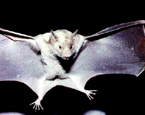|
Antillean
Fruit-eating Bat
(Brachyphylla cavernarum) |
||||
|
|
Physical
characteristics and distribution
|
|
B.
cavernum has a head and body length of 65-118 mm, the tail
is vestigial and concealed in the base of the interfemoral membrane,
and forearm length 51-69 mm. Adult weights are about 45 grams.
Coloration is ivory yellow tipped with sepia on the upperparts,
but there are patches on the neck, shoulders and sides where
the hairs do not have the sepia tips. The underparts are usually
brown. Colonies
of B. cavernum are usually quite large, with as many
as 10,000 individuals estimated in one roost in Cuba. Adults,
subadults and young of both sexes are all found within one colony,
with relatively few barren females. |
|
Description
of the brain
|
|
Animal
source and preparation
|
|
All
specimens collected followed the same preparation
and histological procedure.
|
Other Related Resources (websites and publications)



